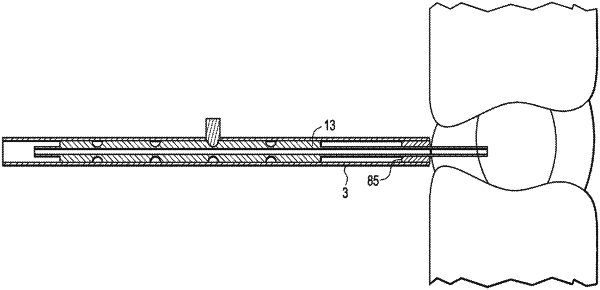|
1. A preassembled elongate device, comprising: an outer tube having a substantially smooth outer surface, an inner surface defining a bore within the outer tube, an open distal end having an annular edge, and a proximal end, the outer tube having a sufficient stiffness and length to penetrate skin and muscle, and wherein the annular edge of the open distal end lies in a plane perpendicular to a longitudinal axis of the outer tube, whereby the annular edge is configured to abut an outer rim of an annulus fibrosus of an intervertebral disc so that the outer tube does not penetrate the annulus fibrosis; an inner elongate member housed within the bore of the outer tube, the inner elongate member having an outer surface, an inner surface defining a bore within the inner elongate member, an open distal end having an annular edge, and a proximal end, wherein the inner elongate member is slidably engaged by the outer tube such that the distal end of the inner elongate member can extend beyond the distal end of the outer tube whereby the inner elongate member has a retracted position and an extended position in relation to the outer tube, and wherein the annular edge of the distal end of the inner elongate member is configured to penetrate the annulus fibrosus and project into a nucleus pulposus of the intervertebral disc when in the extended position; a locking mechanism configured to provide releasable frictional engagement between the outer tube and the inner elongate member, wherein the locking mechanism controls slidable movement of the inner elongate member relative to the outer tube and thereby substantially prevents movement of the inner elongate member relative to the outer tube when the locking mechanism is engaged and allows the distal end of the inner elongate member to extend beyond the distal end of the outer tube when the locking mechanism is disengaged; further comprising an annular plug disposed within the distal end of the outer tube and adapted to fit between the outer tube and the inner elongate member, wherein the annular plug forms a seal that prevents fluid from entering a distal end of the bore of the outer tube.
|
